A version of this article was published in the Alpine Gardener, the journal of the Alpine Garden Society, in June 2021. I was travelling with Andreas Groeger*, who provided all the scientific detail.
Unless you’re visiting the Republic of Georgia in March to see the snowdrops in the west of the country, plant enthusiasts tend to visit the country in late May and June, travelling north to Kazbegi in the Greater Caucasus to the magnificent alpine meadows.
But as we were there relatively early, in mid-late April, we took the opportunity to go hunting for snowmelt geophytes on the high altitude Javakheti plateau.
We took a circular route from T’bilisi, tracking the Mtkvari (or Kura) river upstream in a 270 km arc to Akhaltsikhe the Lesser Caucasus, taking in the famous twelfth century cave monastery of Vardzia, before returning via Ninots’minda and Lake Paravani over the plateau.
Here I’ll try to describe the landscapes and their plants. Even if you’re not a great botanist, the gorgeous landscapes and rich history of this route offer a fantastic few days of exploring.
Dry scrubby hills
First stop, the hinterland of Mtskheta, the old capital of Georgia, where the low, deeply riven hills are still covered with dry oak-juniper forest, which has been lost in many parts of the country.

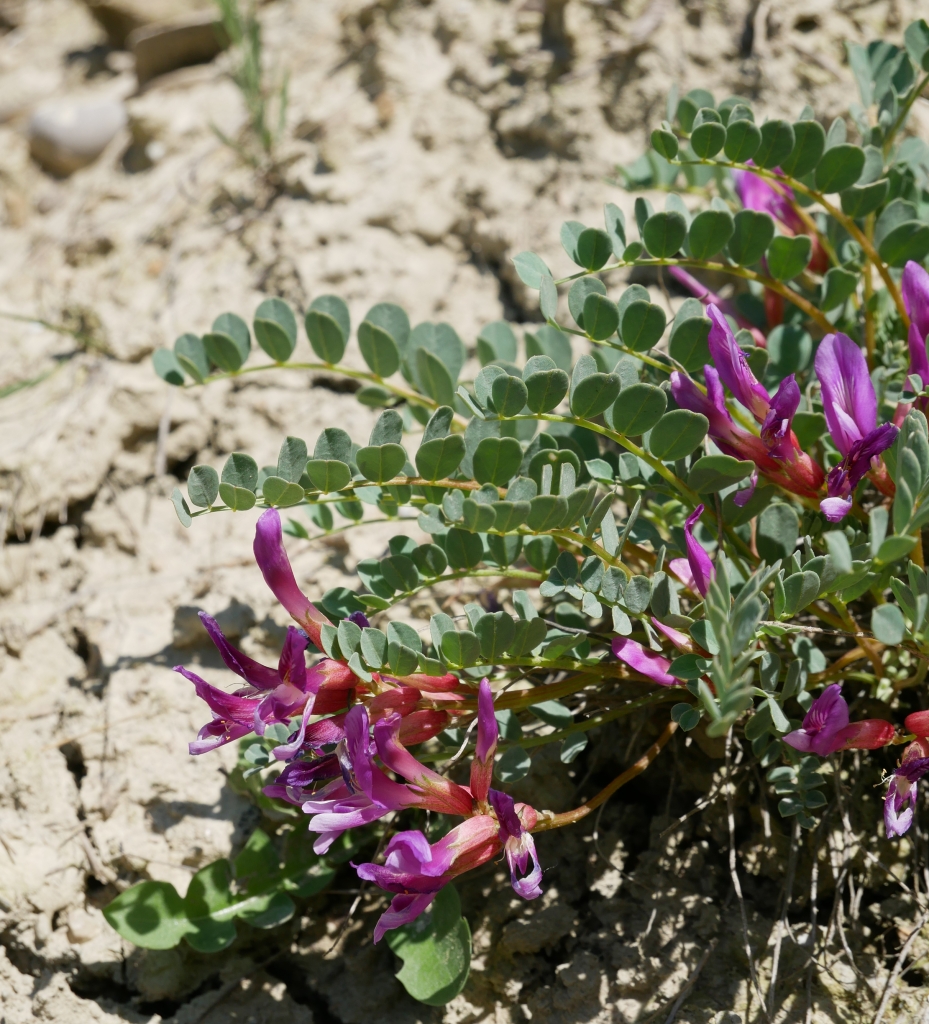
Scrambling up through stony gulleys, we were rewarded by Tulipa undulatifolia var. undulatifolia (syn T. eichleri), sparsely scattered on the ridges. Its solitary wide bell-shaped scarlet flowers have a dark basal blotch with yellow margins. It has spreading, deeply wavy, glaucous leaves that looked especially striking because of the shadows they threw in the bright spring sunshine. Given how particular it seemed to be about its location and lack of competition, it has a surprisingly broad range, from the south Balkan Peninsula (see Northumberland Diary, April 2019) to west and central Turkey, and the eastern Caucasus.
Just below the ridges, the gentle grassy slopes were starry with Ornithogalum woronowii, the Caucasian version of the widespread O. orthophyllum. The pedicels of the lower flowers are much longer than the upper ones, resulting in an umbel-like appearance of the racemose inflorescence. Growing alongside it relatively frequently was a Bellavalia sp. that we couldn’t identify.
On a steep south-facing slope created by a landslide we found one of Georgia’s most exquisite astragalus species, Astragalus glaucophylloides, with its arcuate leaves composed of 10-12 pairs of rounded, glaucous leaflets. It needs a full sun and sharp drainage and its range is restricted to the southern Transcaucasus and bordering Turkey.
Rocks above the river
We continued along the main highway that links Tbilisi with the Black Sea coast, and then turned south with the Mtkvari river towards Borjomi, famous for its mineral springs. On the roadside rocks we found colonies of white and blue Muscari armeniacum, and sprawling mats of the Veronica liwanensis. The preferred habitat of this striking speedwell are sunny, rocky slopes and screes, from the lowlands up to 2400 m. It grows from a woody base, and has oval, slightly glaucous leaves and intensely blue flowers. In recent years, nurseries have begun to offer this robust species for rock gardens and as ground cover.

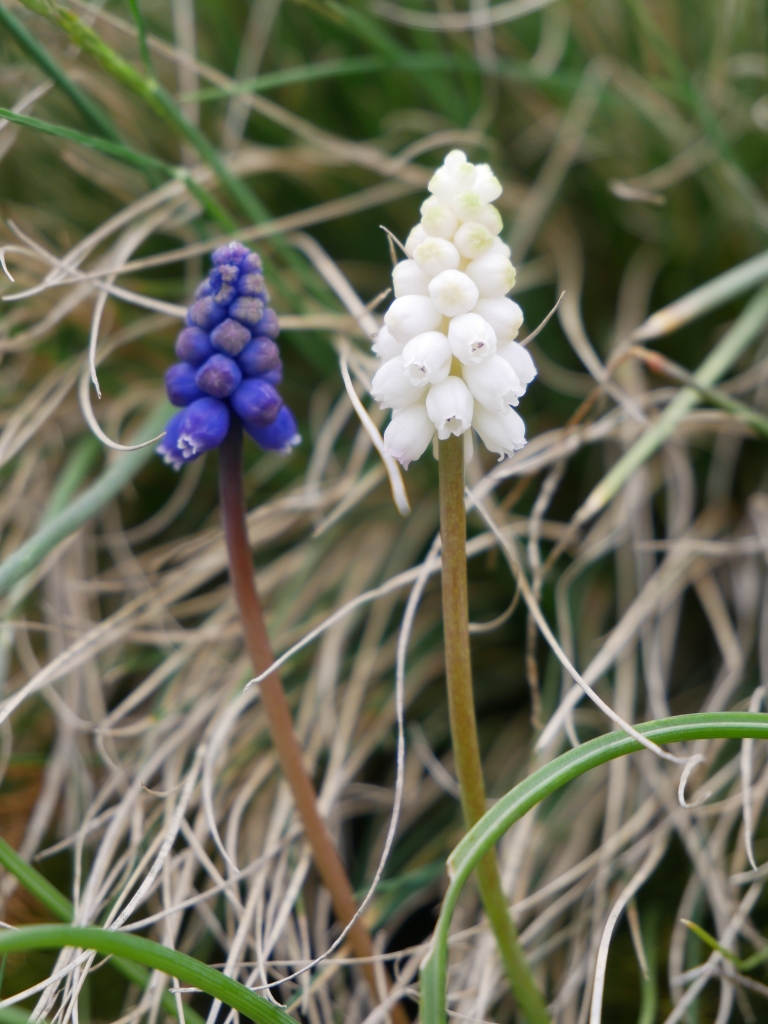
Sapara monastery
At Akhaltsike a 10km detour took us to the Sapara monastery, cupped in a sheltered cleft in the steep hills at 1,300m asl, surrounded by mixed woodland. Dating from the ninth century, the beautiful complex has tenth and thirteenth century churches, and well-preserved fourteenth century frescoes. A grassy roadside slope on a woodland margin was full oxslips and the pretty, white Corydalis angustifolia (its flowers are like little albino orcas), which ranges from the Crimea and north-east Turkey, through the Caucasus to northern Iran. In the sparse woodland we saw more Muscari armeniacum, and white and blue forms of Pulsatilla albana. On bare rock above the site were several Astragalus humifusus, a relatively small, prostrate milkvetch that occurs on rocky cliffs in the forest belt of the Caucasus region and northern Turkey. In the flora of Georgia it is described with four different species names!

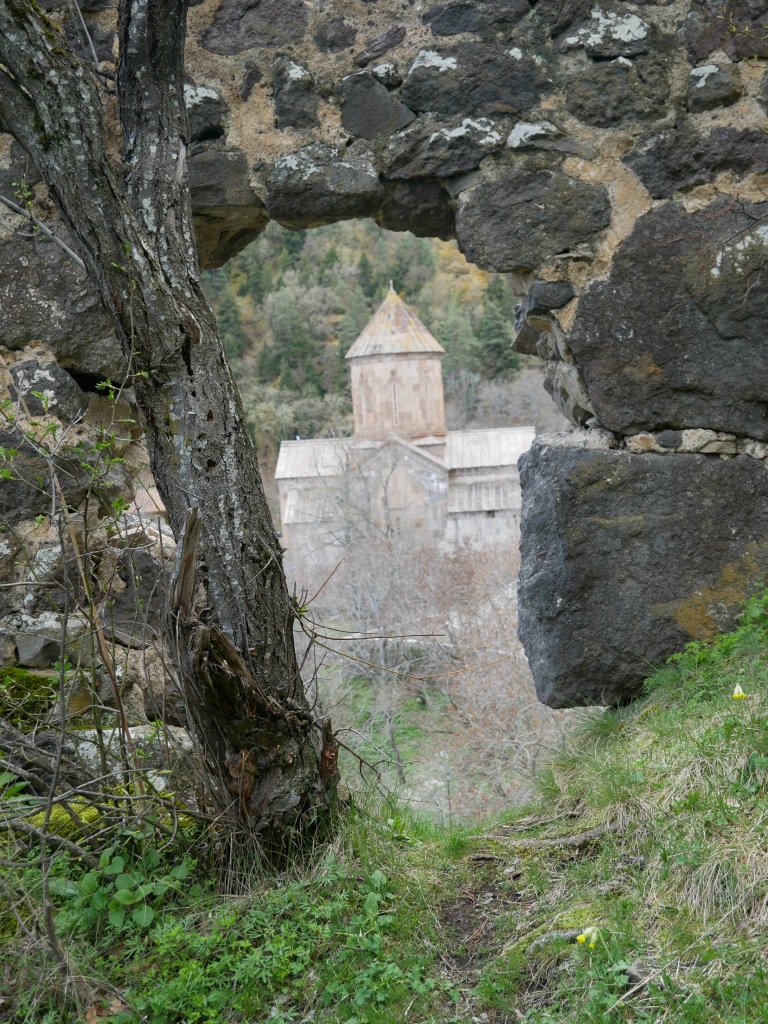
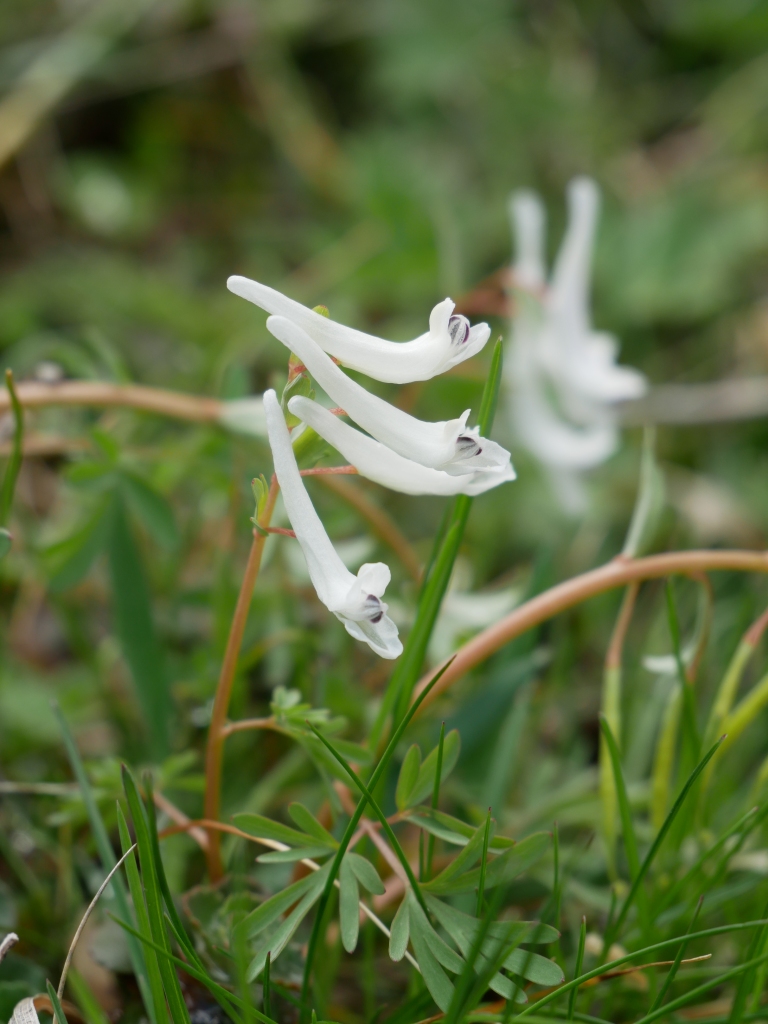
Back on the road again, we travelled south-east to the impressive fourteenth century Khertvisi fortress (built on the site of a much more ancient citadel) perched high above the confluence of the Mtkvari and Paravani rivers. Then we turned south again, following the Mtkvari up the long, gently climbing, steep-sided valley, with signs of abandoned terraces here and there.
The cave monasteries at Vardzia and Vanis Kvabebi
At Vardzia, at 1,300m, the valley widens. Willow and Prunus trees (perhaps peaches?) were just coming into flower and the valley was full of the lovely muted colours of early spring. We met a bee-keeper with perhaps 50 hives, who overwintered there and got his first honey harvest from willow, before taking his bees up to the high meadows in summer.

There are two breathtaking and extensive cave monasteries on opposite sides of the valley, east facing Vardzia and west facing Vanis Kvabebi. At Vanis Kvabebi, a flamboyant Solanaceae was growing strongly on a high terrace in the rain shadow of an overhanging cliff. Physochlaina is an Asian genus of the nightshade family (Solanaceae), comprising 8-11 species (6 species in the Flora of China), related to the henbane (Hyoscyamus, both genera have 2-locular capsules). Physochlaina orientalis is the westernmost representative of the genus (distribution range northwest Iran to northeast Turkey, 1400 – 1500 m). Described by the great Ukrainian botanist Alexander Alfonsovich Grossheim, the location of the type specimen was the entrance to a cave, and this appears to be its favourite habitat, where the thick rhizomes secure the plant in shallow, well-drained, gravelly soil. It has been cultivated successfully at Munich Botanic Gardens, growing to about 40cm tall.
In meadows in the narrow valleys leading away from the main river valley we found Fritillaria caucasica. Though not as showy as other fritillaries, it is very elegant, growing to 20cm tall. In Georgia it is the fritillary of lower altitudes, and is also found in steppe vegetation around Tblisi. The rounded flower has a plum-like colour, and a comparatively long style. The distribution of F. caucasica extends into Armenia and Northeastern Turkey, where it shows transitions to other species, like F. armena and F. pinardii.

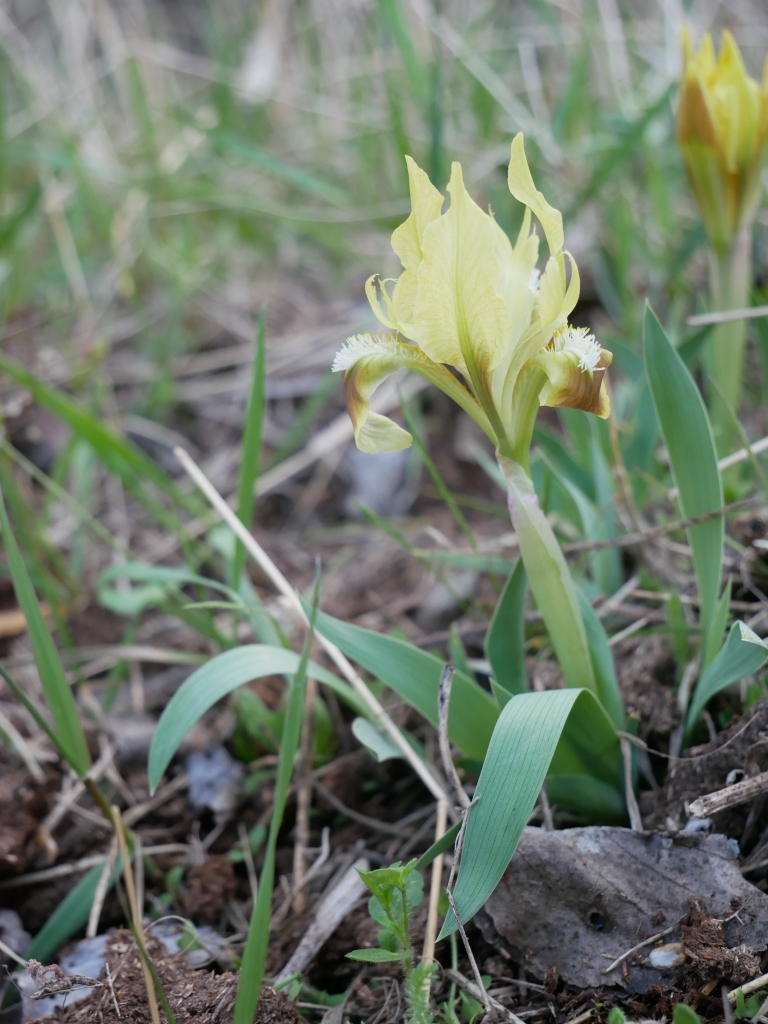
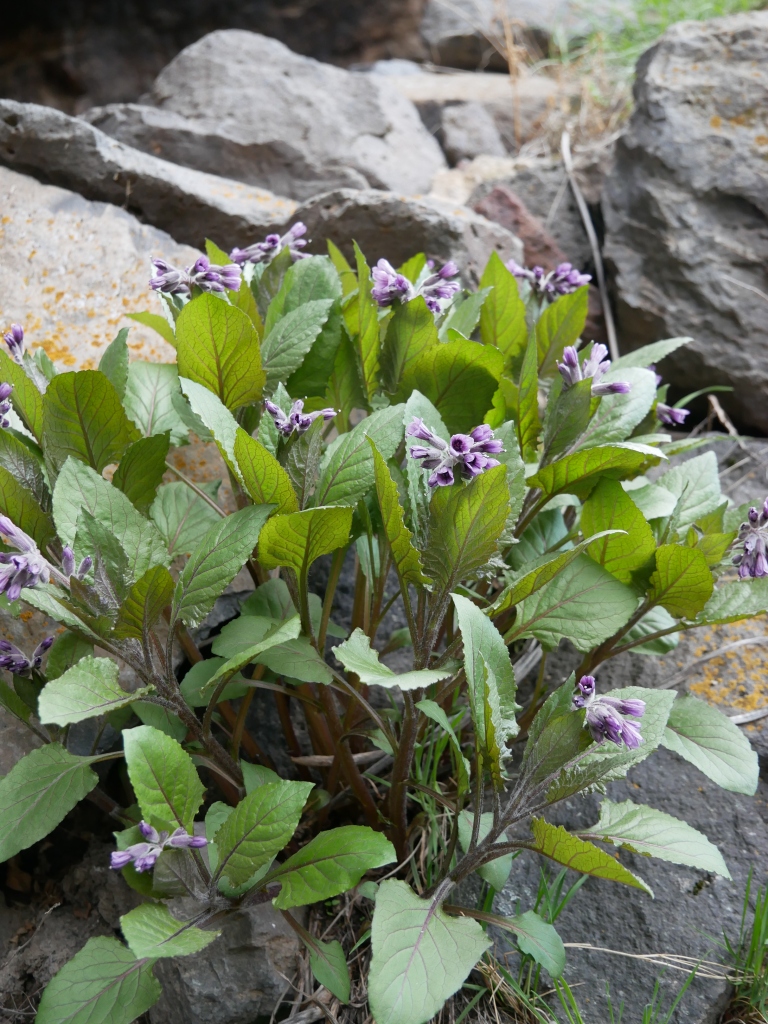
The yellow form of Iris pumila was growing among shrubs in a roadside meadow. The solitary flowers are borne on a short stem (less than 10 cm), on a very short pedicel with a long, slender perianth tube sheathed by two narrow bracts. The basal leaves elongate after flowering. The type form is purple, but there is a lot of colour variation. It has a wide native range, from Austria to the Caucasus and the Ural Mountains, where it grows in dryish, grassy habitats.
Javakheti plateau
Our journey back to Tbilisi took us via Akhalk’alaki and Ninots’minda, where the storks were already building enormous nests on every telegraph pole. On the vast open plain we passed a large railway depot on the recently constructed railway from Azerbajan’s capital Baku on the Caspian sea to Kars in north eastern Turkey, part of the huge Chinese infrastructure belt and road project, the new Silk Road. Large developments are nothing new, as the megalithic monuments and fortresses attest. One of the main routes to Byzantium ran through this region and it has been subject to waves of settlers over the centuries.

The Javakheti plateau is a volcanic plateau mostly above 2000m, now a treeless alpine steppe, although natural subalpine forest occurs around Lake Kartsakhi on the Georgia-Turkey border. Its wetlands and shallow lakes make it a place of international importance for birds. The plain is crossed from north to south by a series of extinct volcanoes, and and intensively grazed, making a truly dramatic, bleak landscape.
We were lucky with the cool, cloudy, dry weather. The snow still lay thick on the ground on northern slopes when we stopped above frozen Lake Paravani, the largest lake in Georgia at 37.5 sq km, with an average depth of 2.2 metres.
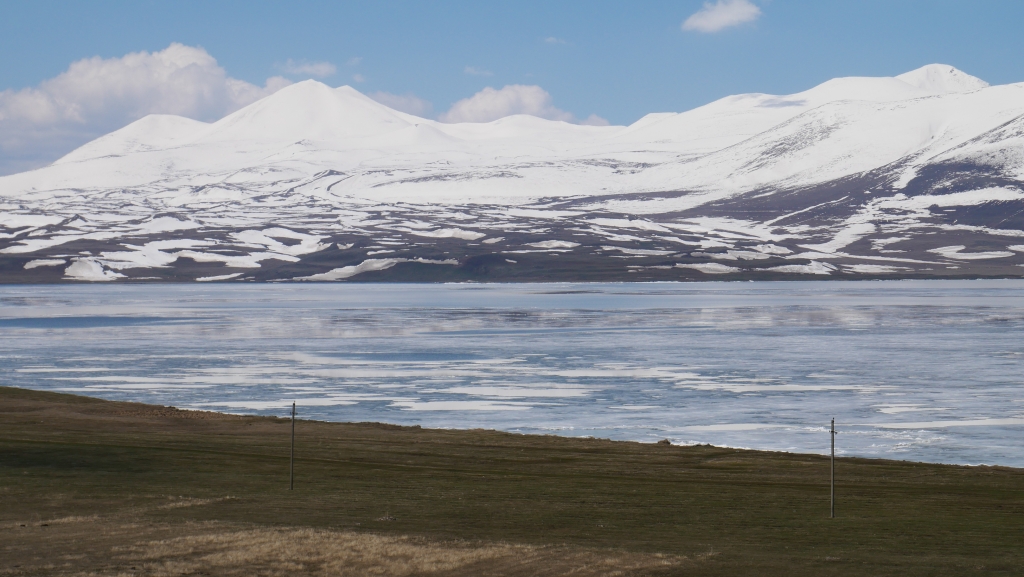
Here, in meadows at 2,100m, which must have been snow covered only days before, among chunks of obsidian glass, were hundreds of thousands of pale pink Colchichum raddeanum and purple Crocus adamii, with occasional tiny Gentiana aquatica.
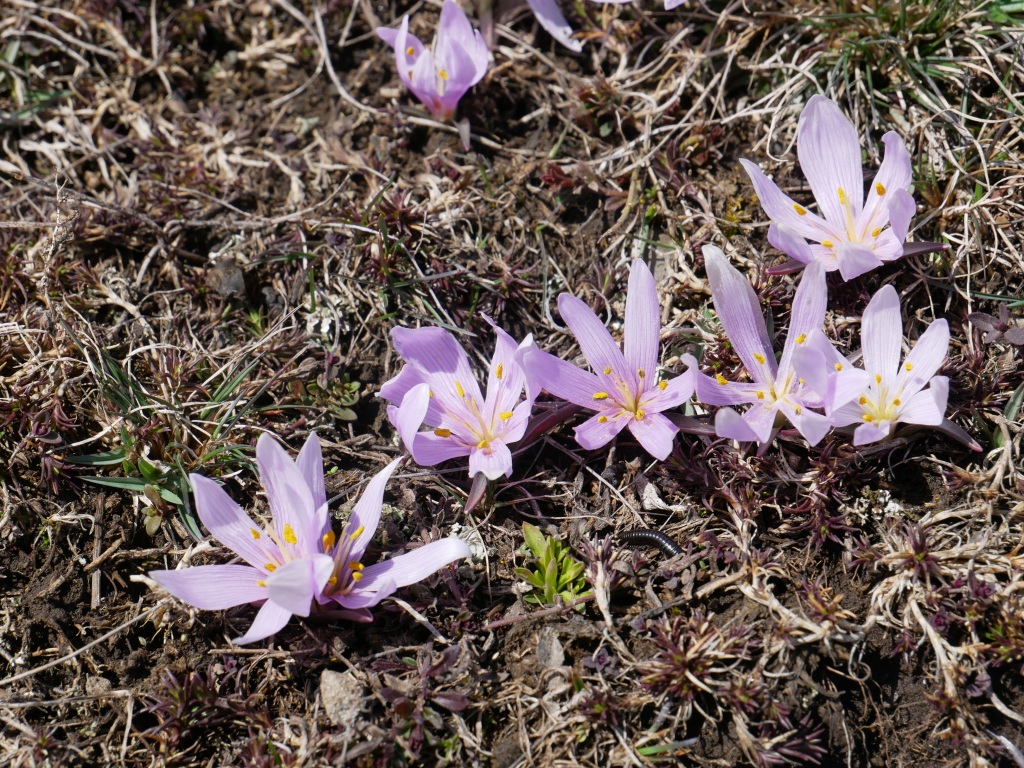
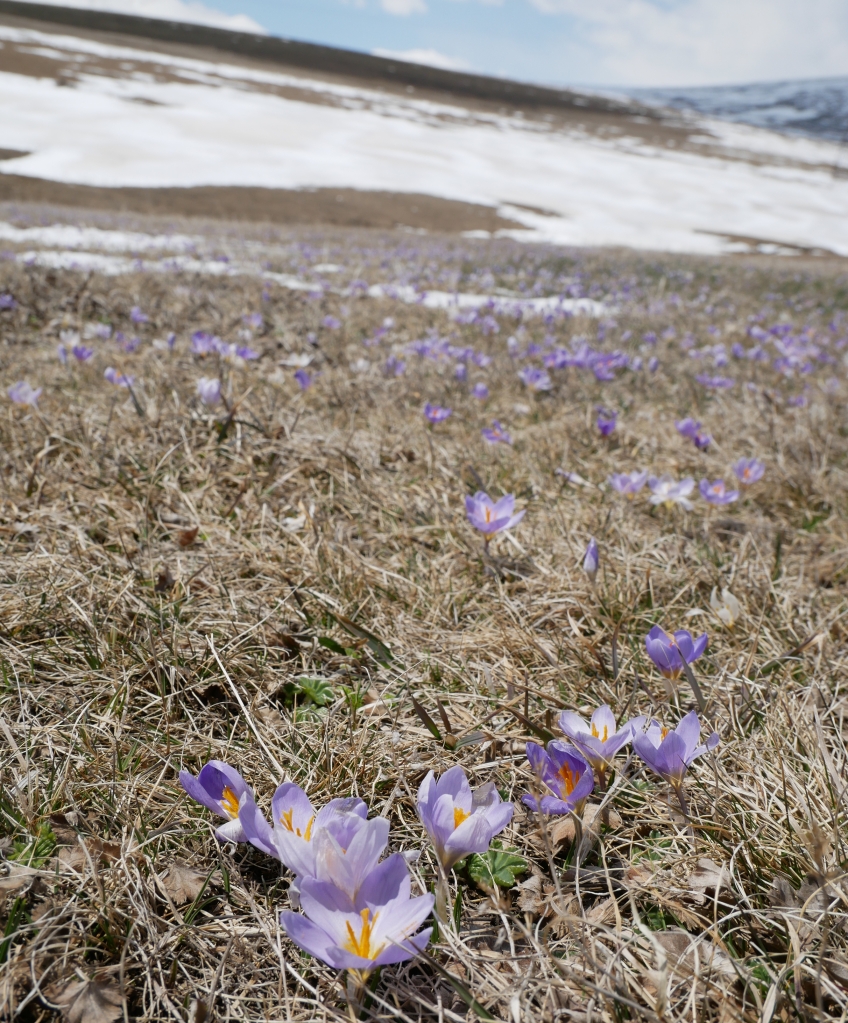
Brian Mathew’s 1982 monograph treated Crocus adamii as a subspecies of C. biflorus, while Janis Rukšans (2016) reinstated it at the species level. Its distribution is restricted to central Transcaucasia. For identification, you have to look closely at the stamens. The anthers are yellow with a pale connective, and only 2-4 mm long. The flattened filaments are 2-3 times shorter than the anthers. There was terrific variation in the colour density and striation of the petals.
Pale pink Colchicum raddeanum (syn. Merendera raddeana) is still under discussion. Some authors sink it into C. trigynum, while others keep them as separate species. It differs by generally having only two leaves and broader perianth segments. The differences are gradual and there are transitional forms. C. raddeanum typically has two leaves, a more globular flower with distinct venation, and dark yellow to greyish anthers. C. trigynum tends to have three leaves, one to three flowers per plant and dark grey to olive-brown anthers. The plants of the Javakheti plateau seem to be intermediate, with overlapping characters.

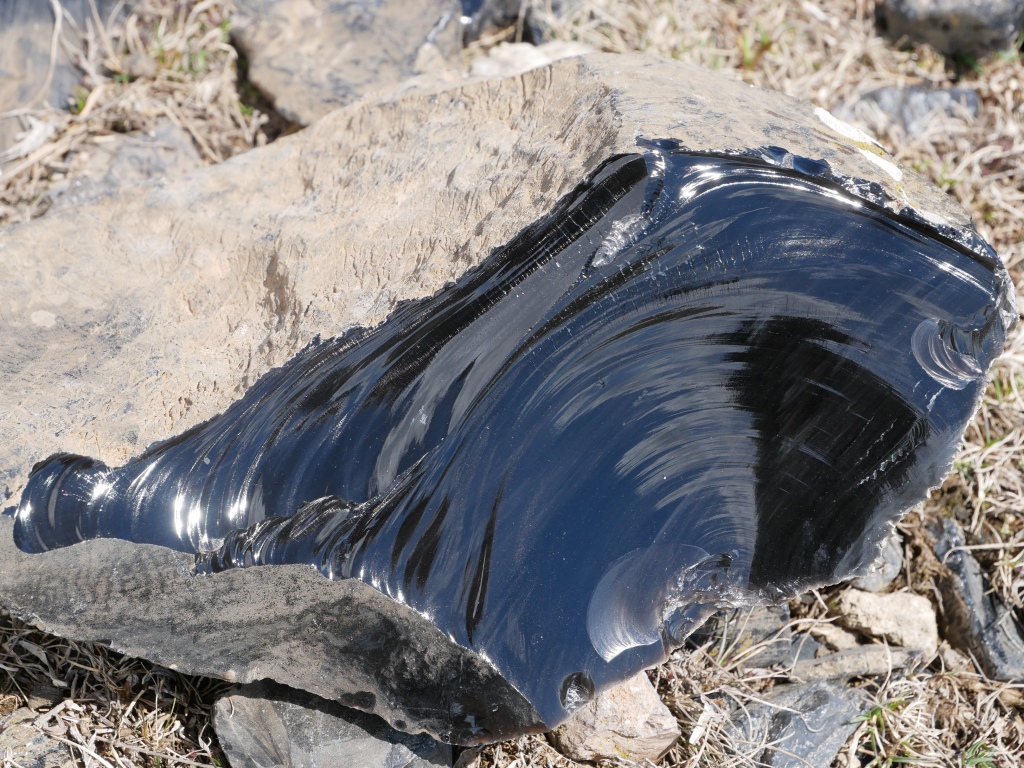
Gagea taurica was flowering en masse on slightly higher, flatter meadows. It belongs to a group of very similar species around Gagea reticulata, and occurs from Crimea to Armenia. The flora of Georgia comprises seventeen Gagea species, which need proper revision.
Return to Tbilisi
Easter is the high point of the orthodox calendar, and a fine time to be in T’bilisi, with warm sunshine (once the rain has passed), bearded iris in the streets, huge displays of wisteria everywhere and a fruit tree full of blossom in every suburban yard. Georgian cuisine is rightly renowned, and among other fine discoveries were Staphylea buds and Smilax, both pickled. On the roadsides, alongside big bunches of fresh herbs Azeri women were selling bundles of madder root, Rubia tinctorum, for dying eggs red, and plates of sprouted wheat on which to display them. These eggs are taken to the cemeteries, and laid on the graves of relatives, along with single stems of iris and tulips. I’ll save all that for another less botanical post.
*Andreas Groeger is co-author of Illustrated Field Guide to the Flora of Georgia (South Caucasus) and scientific curator of Munich Botanic Gardens.
Hopefully you can trace our journey on the map below. Follow the Mtkvari river from T’bilisi west and then south west via Borjomi to Akhaltsikhe. Turn south east down to Ninots’minda and then north east past Lake Paravani and back to T’bilisi.


